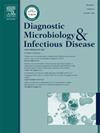BioFire®bid2对儿童革兰氏阴性血流感染的抗菌治疗和死亡率的影响
IF 1.8
4区 医学
Q3 INFECTIOUS DISEASES
Diagnostic microbiology and infectious disease
Pub Date : 2025-07-11
DOI:10.1016/j.diagmicrobio.2025.117003
引用次数: 0
摘要
目的:快速分子诊断,如BioFire®bid2 Panel,可以通过促进早期病原体鉴定和抗菌药物管理来改善临床结果。本研究评估了bid2实施对儿童革兰氏阴性血流感染(BSI)的抗菌治疗和死亡率的影响。方法将微生物学证实为革兰氏阴性BSI的儿科患者分为两组:bbcid2前组(常规血培养诊断)和bbcid2组(bbcid2 Panel诊断)。主要结局包括病原体鉴定时间和抗菌治疗改进。次要结局包括7天和30天死亡率。结果共分析97例革兰氏阴性BSI发作(BCID2前59例,BCID2前38例)。bid2组显著缩短了接受适当抗菌药物治疗的时间(中位数减少:55.1小时,p <;0.01)。78.9%的病例在bbcid2结果后修改了抗菌药物治疗,其中42.1%的病例因耐药基因检测而需要改变。28.9%的患者停止使用糖肽。bid2组的7天死亡率为10.5%,而bid2前组为8.5% (p >;0.05)。结论bid2检测显著加快了病原菌和耐药基因的鉴定,促进了儿童革兰氏阴性BSI抗菌药物的合理使用。本文章由计算机程序翻译,如有差异,请以英文原文为准。
Impact of the BioFire® BCID2 panel on antimicrobial treatment and mortality in pediatric gram-negative bloodstream infections
Purpose
Rapid molecular diagnostics, such as the BioFire® BCID2 Panel, may improve clinical outcomes by facilitating earlier pathogen identification and antimicrobial stewardship. This study evaluates the impact of BCID2 implementation on antimicrobial treatment and mortality in pediatric Gram-negative Bloodstream infections (BSI).
Methods
Pediatric patients with microbiologically confirmed Gram-negative BSI were divided into two groups: the pre-BCID2 group (diagnosed using conventional blood cultures) and the BCID2 group (diagnosed using the BCID2 Panel). Primary outcomes included time to pathogen identification and antimicrobial treatment modifications. Secondary outcomes included 7-day and 30-day mortality rates.
Results
A total of 97 Gram-negative BSI episodes were analyzed (pre-BCID2: 59, BCID2: 38). The BCID2 panel significantly reduced the time to appropriate antimicrobial therapy (median reduction: 55.1 h, p < 0.01). Antimicrobial treatment was modified in 78.9 % of cases following BCID2 results, with 42.1 % requiring changes due to resistance gene detection. Glycopeptide use was discontinued in 28.9 %. The 7-day mortality rate was 10.5 % in the BCID2 group versus 8.5 % in the pre-BCID2 group (p > 0.05).
Conclusions
The BCID2 panel significantly accelerated pathogen and resistance gene identification, leading to improved appropriate antimicrobial usage in pediatric Gram-negative BSI.
求助全文
通过发布文献求助,成功后即可免费获取论文全文。
去求助
来源期刊
CiteScore
5.30
自引率
3.40%
发文量
149
审稿时长
56 days
期刊介绍:
Diagnostic Microbiology and Infectious Disease keeps you informed of the latest developments in clinical microbiology and the diagnosis and treatment of infectious diseases. Packed with rigorously peer-reviewed articles and studies in bacteriology, immunology, immunoserology, infectious diseases, mycology, parasitology, and virology, the journal examines new procedures, unusual cases, controversial issues, and important new literature. Diagnostic Microbiology and Infectious Disease distinguished independent editorial board, consisting of experts from many medical specialties, ensures you extensive and authoritative coverage.

 求助内容:
求助内容: 应助结果提醒方式:
应助结果提醒方式:


